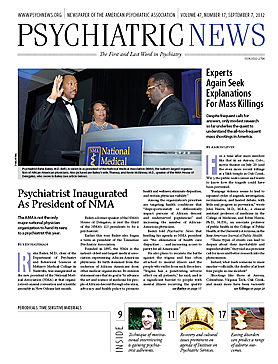Do “prevention” and “psychiatry” even belong in the same sentence? Clearly, there is no immunization against mental illnesses. However, appropriate health promotion, elimination of high-risk factors, and well-tailored interventions can lead to substantial reductions in mental health disability. In fact, mounting evidence suggests that prevention in psychiatry is both practical and cost-effective.
Better sanitation, vaccines, improved perinatal care, and other medical advances introduced during the last century have dramatically improved the quality of life and eradicated many devastating medical diseases. Today similar long-term and intersectoral preventive measures are needed in the arena of mental health. Mental illnesses are still imposing an enormous psychological, social, and economic burden on society and are associated with increased morbidity and mortality. Even a cursory look at the statistics is eye opening: 1 in 4 Americans will develop a psychiatric disorder during his or her lifespan. Further efforts to expand the spectrum of prevention in psychiatry would be highly beneficial for patients, communities, and societies.
Psychiatrists have been alleviating the symptoms of depression, schizophrenia, and other diseases and trying to minimize the risk of complications, such as disability, physical illness, and suicide. However, the question is whether we can prevent mental illnesses from developing in the first place, or at least prevent their clinical manifestations so they remain dormant throughout life. Admittedly, this would be an ambitious undertaking, as most psychiatric disorders are multi-determined. For instance, depression might have causal pathways ranging from genetic predisposition to social factors to the use of certain depressogenic drugs. Some of these causes are currently preventable, others are not. Yet protecting individuals from developing a clinical illness, even in the presence of the underlying risk factor, is not a futuristic fantasy. An excellent example is a debilitating intellectual disability and seizure disorder associated with phenylketonuria (PKU). Patients who are diagnosed early and maintain a strict special diet for PKU can have a normal lifespan with normal mental development.
In 2009, the Institute of Medicine issued a remarkable report titled “Preventing Mental, Emotional, and Behavioral Disorders Among Young People: Progress and Possibilities.” It showed how behavioral health could learn from public health in endorsing a population health perspective. It gave examples of evidence-based kernels and “behavioral vaccines” that have been found to reduce mental, emotional, and behavioral problems at the community level. Thus, simple strategies such as positive notes from home, group public feedback with group rewards, reduction in TV viewing and video game use at home, and cooperative games on the playground have been shown to reduce aggression at school, even among very high-risk children or adolescents.
In 2011, Carl Bell and I published a volume on prevention in psychiatry from a lifespan perspective (Prevention in Mental Health: Lifespan Perspective, W.B. Saunders Co.). Our goal was to discuss how prevention is not restricted to children and youth, but also can be practiced in adulthood, including old age. Depression has been studied most extensively from this viewpoint, and several types of preventive interventions have been shown to be effective. Thus, the likelihood of adolescent depression can be reduced in the offspring of parents with a history of the disease through measures such as individually targeted psychotherapy, strategies for improving self-esteem, and encouraging quality relationships with caring adults. Similarly, early screening for depression and intensive support and counseling can reduce the risk of postpartum depression in mothers.
Finally, there is a growing body of research on preventing development of depression that commonly follows myocardial infarction, cardiac bypass surgery, and strokes. Other malleable risk factors for depression include physical disability, sleep problems, social isolation, and a lack of stimulating environment or activities. Interventions aimed at altering such factors or their consequences can be successful in preventing the onset of depression across the lifespan.
Another line of research suggests that posttraumatic stress disorder (PTSD) presents an opportunity for preventive measures. Counseling victims of natural disasters, wars, or other tragic events can prove beneficial in substantially lowering the risk of developing PTSD throughout the lifespan.
Fostering positive psychosocial traits, such as optimism, resilience, self-efficacy, and spirituality, has been shown to be effective in promoting mental health and preventing psychopathology.
People who are optimistic about the future, who are resilient after stressful events, and who are confident in their abilities to manage day-to-day affairs tend to experience better cognitive and emotional health following negative life events, even in older age. In addition, the burgeoning fields of genetics and genomics hold a promise that, in the near future, prevention in psychiatry will be even more effective. With better understanding of psychiatric genetics, we might be able to identify genetic risk factors for a number of mental illnesses. We could then improve screenings and develop biological and psychosocial/behavioral treatments that would positively impact the expression of relevant genes.
While more research on various aspects of psychiatric prevention is obviously needed, applying current knowledge in clinical practice can contribute to reducing a number of the psychiatric disabilities. Well-designed and implemented preventive strategies should lead to significant reduction in the burden of many psychiatric diseases. Preventive psychiatry is not an oxymoron!


